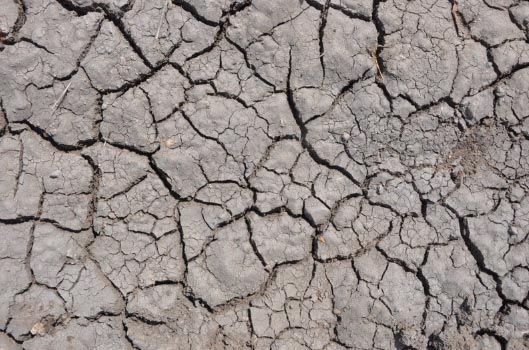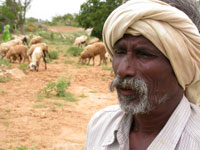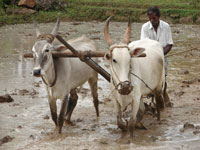An Appeal for Mitigating the Impact of Drought
Deficient monsoon puts the farmers’ livelihood at risk
The rain, which is vital for the 55 percent of Indian farmland without irrigation, is still eight per cent short of average so far in the June to September season of southwest monsoon. Two-third of the cultivated land in India is entirely dependent on rainfall. The south west monsoon which is the most predominant one, as this monsoon rain helps for the bulk of the rainfed cultivation in states like Andhra Pradesh, Karnataka, Maharashtra, Orissa and other Northern states.
 Rainfall directly affects sowing which in turn affects crop production. The deficient and unevenly distributed rainfall has invariably been associated with decline in production. The shortage of rains in some drought-hit areas of the west and south has curbed planting of cereals and pulses, threatening output. This almost nullifies the prospects of a good rainfed crop. The small and marginal farmers involved in rainfed farming are now in a deep crisis for their basic requirements of food and water. In many parts of the drought hit states in India, the farmers have started to migrate to the urban areas seeking some alternate livelihood. Many of them have also made distress sale of their belongings including the cattle as rearing cattle has become highly untenable.
Rainfall directly affects sowing which in turn affects crop production. The deficient and unevenly distributed rainfall has invariably been associated with decline in production. The shortage of rains in some drought-hit areas of the west and south has curbed planting of cereals and pulses, threatening output. This almost nullifies the prospects of a good rainfed crop. The small and marginal farmers involved in rainfed farming are now in a deep crisis for their basic requirements of food and water. In many parts of the drought hit states in India, the farmers have started to migrate to the urban areas seeking some alternate livelihood. Many of them have also made distress sale of their belongings including the cattle as rearing cattle has become highly untenable.
The effect of drought on our farmers
 Out of the one million poor households in 12 Indian states with whom DHAN Foundation is working, one third of the households are involved in farming at small and marginal scale. They are supported by their Primary groups and Federations through a number of activities such as creation of soil and moisture conservation structures in individual farmlands and for common use, savings, credit and insurance services to support their livelihoods, creation of favorable markets for their farm inputs and produces.
Out of the one million poor households in 12 Indian states with whom DHAN Foundation is working, one third of the households are involved in farming at small and marginal scale. They are supported by their Primary groups and Federations through a number of activities such as creation of soil and moisture conservation structures in individual farmlands and for common use, savings, credit and insurance services to support their livelihoods, creation of favorable markets for their farm inputs and produces.
The adverse effects of the monsoon have made the poor farmers helpless and they are unable to repay their loans to their groups. Considering the situation, the groups have started re-scheduling their loans. This however would not be sufficient to redeem them from the shock.
It is our endeavor to support these needy farmers with financial assistance like interest free loans besides access to subsidized inputs to take up agriculture and allied activities, get into alternative livelihoods to cushion the shock. For all these interventions we seek support from the donor agencies and kind hearted individuals not only to relieve the affected poor from the present setback to their livelihoods but also to create a sustainable mechanism to avert the future shocks as well.
How can your support help the drought hit farmers?
 Your support and assistance would be helpful to the Farmers’ Federations to create a drought relief fund to take up drought relief measures suiting to the local needs. The grant would be made available to the small and marginal farmers as interest free loans to take up different activities. The repaid loans would be pooled and kept as a revolving fund in the name of ‘Drought Relief Fund’, which would be used in similar circumstances in the future. In 2003-04, a similar initiative of drought relief was taken up with the support of Oxfam Novib, the Netherlands
Your support and assistance would be helpful to the Farmers’ Federations to create a drought relief fund to take up drought relief measures suiting to the local needs. The grant would be made available to the small and marginal farmers as interest free loans to take up different activities. The repaid loans would be pooled and kept as a revolving fund in the name of ‘Drought Relief Fund’, which would be used in similar circumstances in the future. In 2003-04, a similar initiative of drought relief was taken up with the support of Oxfam Novib, the Netherlands
Where is the support needed?
As said earlier the States of Karnataka, Andhra Pradesh, Maharashtra and Orissa are worst affected. DHAN Foundation works in these states, with poor households, particularly small and marginal farmers. District wise impact of drought and assistance needed has been given below:
District |
Extent of drought impact |
Support needed |
| Andhra Pradesh | ||
| Chittoor (Palamaner, Punganur, Gudipala, Udayagiri Mandals) |
|
Over 12000 farmers in 300 villages are in desperate need as they have completely lost their crops. |
| Karnataka | ||
| Kolar (Kolar and Bethamangala blocks) |
|
Over 10000 farmers in 1100 villages are in critical need of support. |
| Tumkur (Pavagada and Sira blocks) |
|
Over 12,000 farm households, who have lost their crop need support |
| Ramanagara (Kanagapura and Magadi blocks) |
|
Around 2100 farmers have been found worst affected and they need assistance |
| Maharashtra | ||
| Districts such as Beed, Nanded, Osmanabad, Pune, Solapur, Yavatmal |
|
Over 15,100 farmers in 26 blocks are affected by drought and they need assistance. |
Relief for the individual farmers
An average assistance needed per farm family would be Rs. 15,000. This will enable them to take up a number of activities such as livestock rearing, purchase of fodder for their livestock, planting horticultural trees and creation of farm ponds. In order to support 50 farmers per village it would require Rs.750,000 per village. The amount will be repaid by the farmers to the ‘drought relief fund’ after a holiday period of two years which will be used for similar problems in the future. This timely assistance will go a long way to support the needy farmers in the drought affected areas.
Relief for the Community
 Similarly, village common works could be taken up with the support from the drought relief fund, which could be matched with the resources mobilised from the Government agencies. Activities such as renovation or creation of drinking water ponds, ponds for cattle and fish rearing, application of tank silts in farm lands, rehabilitation of waterways and irrigation tanks. Each village may need assistance to the tune of Rs. 200,000.
Similarly, village common works could be taken up with the support from the drought relief fund, which could be matched with the resources mobilised from the Government agencies. Activities such as renovation or creation of drinking water ponds, ponds for cattle and fish rearing, application of tank silts in farm lands, rehabilitation of waterways and irrigation tanks. Each village may need assistance to the tune of Rs. 200,000.
We invite kind-hearted individuals and philanthropic organisations to join us in this endeavor to find a sustainable solution for this recurring problem.
Please reach us for further information!
M. Santhanam
Centre for Facilitating Philanthropy
DHAN Foundation
Email: cfpdhan@dhan.org
Phone: (0452) 2610794 / 2610805
Fax: (0452) 2602247
Mobile: 9944934080
stories
Turning the tide - Enabling poverty reduction
 It is rare to find a woman shoulder the responsibility of farming. It is usually the male counterpart who takes up the farm responsibility, but it is not so in the life of Kamatchi.
It is rare to find a woman shoulder the responsibility of farming. It is usually the male counterpart who takes up the farm responsibility, but it is not so in the life of Kamatchi.
